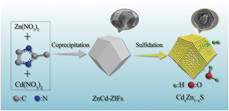Crossref Citations
This article has been cited by the following publications. This list is generated based on data provided by
Crossref.
Mu, Feihu
Cai, Qiong
Hu, Hao
Wang, Jian
Wang, Yun
Zhou, Shijian
and
Kong, Yan
2020.
Construction of 3D hierarchical microarchitectures of Z-scheme UiO-66-(COOH)2/ZnIn2S4 hybrid decorated with non-noble MoS2 cocatalyst: A highly efficient photocatalyst for hydrogen evolution and Cr(VI) reduction.
Chemical Engineering Journal,
Vol. 384,
Issue. ,
p.
123352.
Chen, Yuerong
and
Jin, Huiming
2020.
Fabrication of amorphous Co–Cr–B and catalytic sodium borohydride hydrolysis for hydrogen generation.
Journal of Materials Research,
Vol. 35,
Issue. 3,
p.
281.
Wei, Xian
Wang, Peng
Fu, Huifen
Zhao, Chen
and
Wang, Chong-Chen
2020.
Boosted photocatalytic elimination toward Cr(VI) and organic pollutants over BUC-21/Cd0.5Zn0.5S under LED visible Light.
Materials Research Bulletin,
Vol. 129,
Issue. ,
p.
110903.
Huang, Danlian
Wen, Ming
Zhou, Chengyun
Li, Zhihao
Cheng, Min
Chen, Sha
Xue, Wenjing
Lei, Lei
Yang, Yang
Xiong, Weiping
and
Wang, Wenjun
2020.
ZnxCd1-xS based materials for photocatalytic hydrogen evolution, pollutants degradation and carbon dioxide reduction.
Applied Catalysis B: Environmental,
Vol. 267,
Issue. ,
p.
118651.
Kharissova, Oxana V.
Kharisov, Boris I.
and
González, Lucy T.
2020.
Recent trends on density functional theory–assisted calculations of structures and properties of metal–organic frameworks and metal–organic frameworks-derived nanocarbons.
Journal of Materials Research,
Vol. 35,
Issue. 11,
p.
1424.
Cheng, Wei
Wang, Yingming
Ge, Shengsong
Ding, Xiaoqian
Cui, Zhiwen
and
Shao, Qian
2021.
One-step microwave hydrothermal preparation of Cd/Zr-bimetallic metal–organic frameworks for enhanced photochemical properties.
Advanced Composites and Hybrid Materials,
Vol. 4,
Issue. 1,
p.
150.
Gautam, Amit
Sk, Saddam
Tiwari, Amritanjali
Abraham, B. Moses
Perupogu, Vijayanand
and
Pal, Ujjwal
2021.
Hot injection-induced synthesis of ZnCdS–rGO/MoS2 heterostructures for efficient hydrogen production and CO2 photoreduction.
Chemical Communications,
Vol. 57,
Issue. 69,
p.
8660.
Nguyen, Ha L.
2021.
Metal–Organic Frameworks for Photocatalytic Water Splitting.
Solar RRL,
Vol. 5,
Issue. 7,
Pandey, Ratnesh K.
2021.
Metal−Organic Frameworks for Carbon Capture and Energy.
Vol. 1393,
Issue. ,
p.
3.
Sun, Hongli
Xue, Wenhua
Fan, Jun
Liu, Enzhou
and
Yu, Qiushuo
2021.
Preparation of Ni12P5-decorated Cd0.5Zn0.5S for efficient photocatalytic H2 evolution.
Journal of Alloys and Compounds,
Vol. 854,
Issue. ,
p.
156951.
Wang, Wei
Yang, Ruixiang
Li, Tao
Komarneni, Sridhar
and
Liu, Baojiang
2021.
Advances in recyclable and superior photocatalytic fibers: Material, construction, application and future perspective.
Composites Part B: Engineering,
Vol. 205,
Issue. ,
p.
108512.
Duan, Yonghua
Gou, Ming-Lei
Guo, Yafei
Cai, Junqing
Song, Wensheng
Liu, Zhen
and
Zhou, Erpeng
2021.
In situ hydrothermal synthesis of TiO2–RGO nanocomposites for 4-nitrophenol degradation under sunlight irradiation.
Journal of Materials Research,
Vol. 36,
Issue. 4,
p.
906.
Rezki, Muhammad
Septiani, Ni Luh Wulan
Iqbal, Muhammad
Adhika, Damar Rastri
Wenten, I Gede
and
Yuliarto, Brian
2022.
Review—Recent Advance in Multi-Metallic Metal Organic Frameworks (MM-MOFs) and Their Derivatives for Electrochemical Biosensor Application.
Journal of The Electrochemical Society,
Vol. 169,
Issue. 1,
p.
017504.
Zhang, Changxin
Li, Dan
and
Xu, Yi
2022.
Mn-doped NiP: Facile synthesis and enhanced electrocatalytic activity for hydrogen evolution.
Journal of Materials Research,
Vol. 37,
Issue. 3,
p.
807.
Fu, Haitao
Zhao, Hongming
Li, Xiaolang
Chen, Fu
Yang, Xiaohong
Xiong, Shixian
Li, Song
and
An, Xizhong
2023.
High-performance visible-light-driven MoS2/CdZnS nanorods for photocatalytic hydrogen production by water splitting.
Powder Technology,
Vol. 429,
Issue. ,
p.
118889.
Hassan, Israr U.
Naikoo, Gowhar A.
Salim, Hiba
Awan, Tasbiha
Tabook, Musallam A.
Pedram, Mona Z.
Mustaqeem, Mujahid
Sohani, Ali
Hoseinzadeh, Siamak
and
Saleh, Tawfik A.
2023.
Advances in photochemical splitting of seawater over semiconductor nano-catalysts for hydrogen production: A critical review.
Journal of Industrial and Engineering Chemistry,
Vol. 121,
Issue. ,
p.
1.
Gonuguntla, Spandana
Vennapoosa, Chandra Shobha
Abraham, B. Moses
Sainath, Annadanam V. Sesha
and
Pal, Ujjwal
2023.
Charge Transfer-Regulated Bimetallic ZnCd-ZIF-8/Graphene Oxide Hybrid Nanostructures for Solar Hydrogen Generation.
ACS Applied Nano Materials,
Ouyang, Yi-Shan
and
Yang, Qing-Yuan
2023.
High-Performance Visible-Light Photocatalysts for H2 Production: Rod-Shaped Co3O4/CoO/Co2P Heterojunction Derived from Co-MOF-74.
Journal of Colloid and Interface Science,
Vol. 644,
Issue. ,
p.
346.
Saini, Isha
Singh, Vinamrita
Hamad, Syed
and
Ram, Sita
2024.
Recent development in bimetallic metal organic frameworks as photocatalytic material.
Inorganic Chemistry Communications,
Vol. 160,
Issue. ,
p.
111897.
Agrawal, Diya
Mahajan, Navya
Singh, Satyapaul A.
and
Sreedhar, I.
2024.
Green hydrogen production pathways for sustainable future with net zero emissions.
Fuel,
Vol. 359,
Issue. ,
p.
130131.





